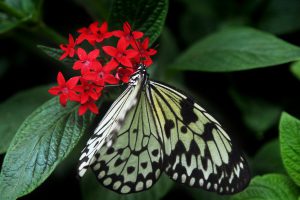
Gardener Question:
I would like to have some butterflies in my yard, but I don’t know what plants they like. How do I know which plants to buy?
Master Gardener Answer:
Since butterflies first appear as eggs, then caterpillars and pupae, they actually need more than just a few nectar plants.
Nectar Plants
Nectar plants will attract them, but larval plants will help them to stay in your yard for more than just a short period of time. A forest or some nearby shrubs will give them shelter during storms, as well as a place to sleep. However, since most adult butterflies love daytime heat, your nectar plants should be in a sunny area. Since most adult butterflies do not live long, it is good to at least try to feed them while they are here.
The nectar plants are the easiest to find, since there are many. The list includes plumbago, firebush, bottlebrush, pentas, jatropha, blackberry lily, hibiscus, tropical sage, and many more. The list of plants that provide both nectar for butterflies and larval food for caterpillars includes native butterfly weed, white swamp milkweed, wild cherry, pawpaw, purple passionflower, corky stemmed passionflower, wild petunia, redbay, purple thistle, beaked butterfly pea, saw palmetto, coontie, cassia, lantana, and wild lime.
Larva Plants
In addition to the nectar plants, you need to add some larva plants for the caterpillars.
Here are a few examples of larval plants that will work for specific butterflies. First, the purple passionflower or the corky passionflower will attract our state butterfly, the Zebra Longwing. A Jatropha bush seems to work for nectar. In contrast to most other butterflies, the Zebra Longwing occurs naturally in moist woods or shrubby areas, so can live in shade as well as sun. It can eat pollen, as well as drink nectar, and can survive for a few months. After eating passion vines, the caterpillar and adult become poisonous to predators.
Fun Facts
- The Giant Swallowtail is sometimes considered a pest in spite of its beauty. This is due to its caterpillars eating citrus leaves. However, at this time, citrus has far worse problems than that. The larvae disguise themselves by looking like bird droppings. Wild Lime tree leaves are also eaten by the Giant Swallowtails. These native trees are related to citrus. Since they don’t get greening, they would be a better choice for your butterflies, but don’t expect edible fruit for yourself.
- The Wild Cherry tree is also supposed to provide larval food for the Giant Swallowtail, as well as the large Eastern Tiger Swallowtail.
- As we have previously learned, the Palamedes Swallowtail and the Spicebush Swallowtail require red bay trees for larval food.
- The Zebra Swallowtail needs pawpaw.
- The Pipevine Swallow should usually not be sought after here, due to its natural larval food being rare or endangered, and the non-native pipevines being either invasive or poisonous to the caterpillars.
The most important thing to remember is that your larval plants will get eaten if you succeed in attracting butterflies. However, these plants are able to recover from the temporary damage, so do not worry. It is also important not to use pesticides on these plants, preferably not anywhere near them either. If your milkweed gets aphids, try blasting them away with a stream of water, so that your caterpillars will be safe.
Need more information:
For more information about Florida Friendly Plants and Wildlife you can email me at epabon5@ufl.edu or like us to learn about new classes or events at Gardening in Central Florida
By: Sandy Switek since 2005 and Eva Maria Pabon Residential Horticulture Agent
Do you want to read more about gardening? Follow our blog Eva Pabon, Author at UF/IFAS Extension Osceola County (ufl.edu)
Source: UF/IFAS Pest Alert
Note: All images and contents are the property of UF/IFAS.



